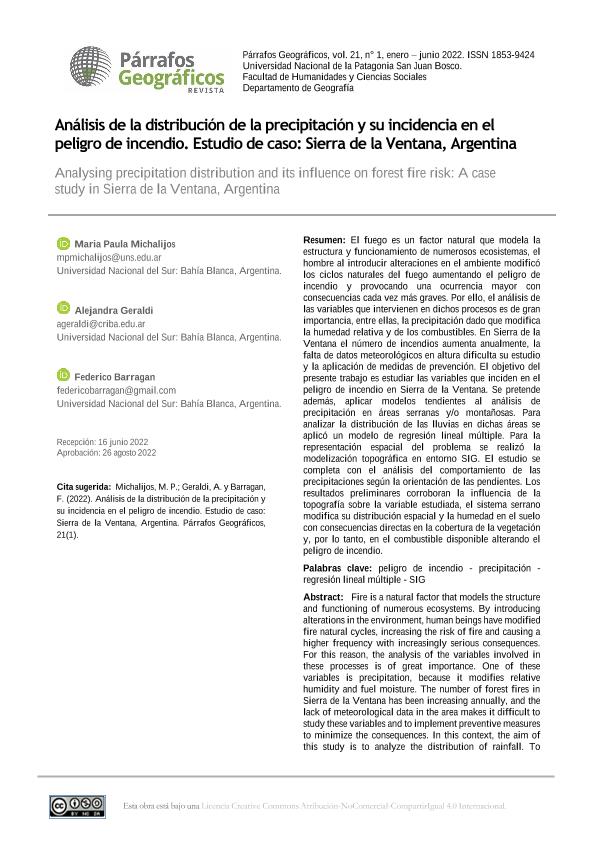Artículo
El fuego es un factor natural que modela laestructura y funcionamiento de numerosos ecosistemas, elhombre al introducir alteraciones en el ambiente modificólos ciclos naturales del fuego aumentando el peligro deincendio y provocando una ocurrencia mayor conconsecuencias cada vez más graves. Por ello, el análisis delas variables que intervienen en dichos procesos es de granimportancia, entre ellas, la precipitación dado que modificala humedad relativa y de los combustibles. En Sierra de laVentana el número de incendios aumenta anualmente, lafalta de datos meteorológicos en altura dificulta su estudioy la aplicación de medidas de prevención. El objetivo delpresente trabajo es estudiar las variables que inciden en elpeligro de incendio en Sierra de la Ventana. Se pretendeademás, aplicar modelos tendientes al análisis deprecipitación en áreas serranas y/o montañosas. Paraanalizar la distribución de las lluvias en dichas áreas seaplicó un modelo de regresión lineal múltiple. Para larepresentación espacial del problema se realizó lamodelización topográfica en entorno SIG. El estudio secompleta con el análisis del comportamiento de lasprecipitaciones según la orientación de las pendientes. Losresultados preliminares corroboran la influencia de latopografía sobre la variable estudiada, el sistema serranomodifica su distribución espacial y la humedad en el suelocon consecuencias directas en la cobertura de la vegetacióny, por lo tanto, en el combustible disponible alterando elpeligro de incendio. Fire is a natural factor that models the structure and functioning of numerous ecosystems. By introducing alterations in the environment, human beings have modified fire natural cycles, increasing the risk of fire and causing a higher frequency with increasingly serious consequences. For this reason, the analysis of the variables involved in these processes is of great importance. One of these variables is precipitation, because it modifies relative humidity and fuel moisture. The number of forest fires in Sierra de la Ventana has been increasing annually, and the lack of meteorological data in the area makes it difficult to study these variables and to implement preventive measures to minimize the consequences. In this context, the aim of this study is to analyze the distribution of rainfall. To achieve this, we propose using interpolation of data that estimates the value of a variable at a given point from known values at other positions. A multiple linear regression is established to obtain the missing data. Finally, the study is completed with the analysis of the rainfall behavior according to the orientation of the slopes. The research is carried out in an environment corresponding to a GIS. Preliminary results corroborate the influence of the topography on the variable studied, the mountain system modifies its spatial distribution and soil moisture which has direct consequences on the vegetation cover and therefore, on the availability of fuel, modifying the risk of fire.
Análisis de la distribución de la precipitación y su incidencia en el peligro de incendio: Estudio de caso. Sierra de la Ventana, Argentina
Título:
Analysing precipitation distribution and its influence on forest fire risk: A case study in Sierra de la Ventana, Argentina
Fecha de publicación:
16/10/2022
Editorial:
Universidad Nacional de la Patagonia San Juan Bosco. Facultad de Humanidades y Ciencias Sociales. Instituto de Investigaciones Geográficas de la Patagonia
Revista:
Párrafos Geográficos
ISSN:
1853-9424
Idioma:
Español
Tipo de recurso:
Artículo publicado
Clasificación temática:
Resumen
Palabras clave:
PELIGRO DE INCENDIO
,
PRECIPITACION
,
REGRESION LINEAL MULTIPLE
,
SIG
Archivos asociados
Licencia
Identificadores
Colecciones
Articulos(IADO)
Articulos de INST.ARG.DE OCEANOGRAFIA (I)
Articulos de INST.ARG.DE OCEANOGRAFIA (I)
Citación
Michalijos, María Paula; Geraldi, Alejandra Mabel; Barragán, Federico Gastón; Análisis de la distribución de la precipitación y su incidencia en el peligro de incendio: Estudio de caso. Sierra de la Ventana, Argentina; Universidad Nacional de la Patagonia San Juan Bosco. Facultad de Humanidades y Ciencias Sociales. Instituto de Investigaciones Geográficas de la Patagonia; Párrafos Geográficos; 21; 1; 16-10-2022; 1-13
Compartir




